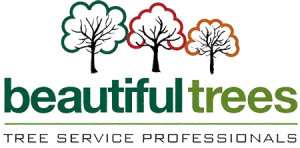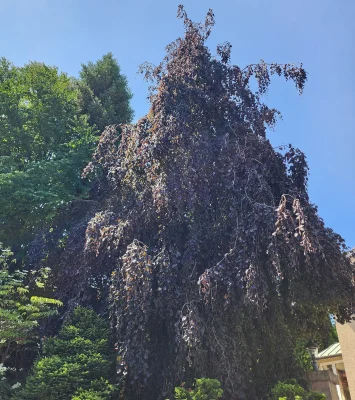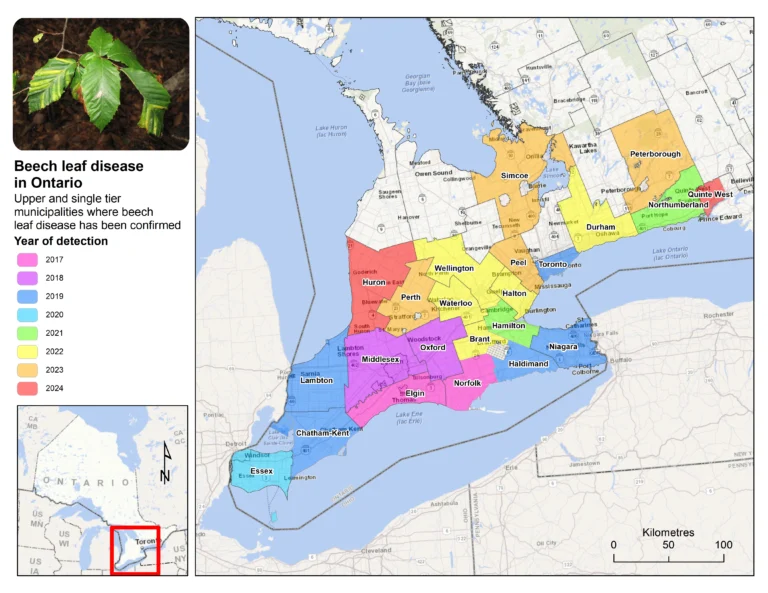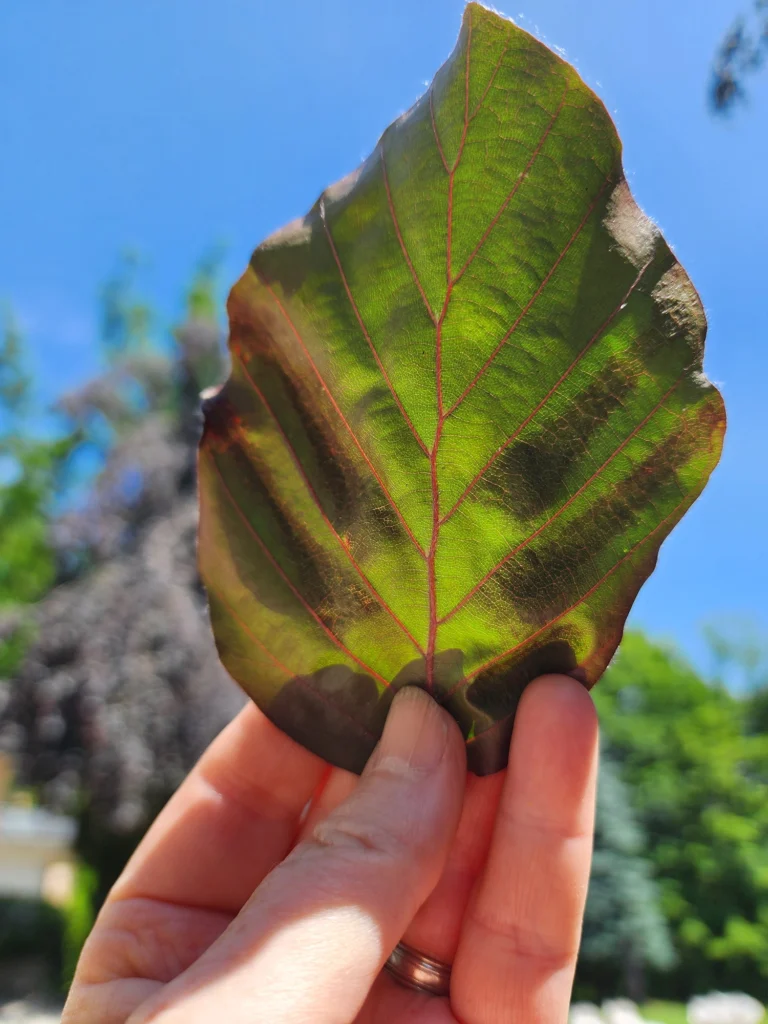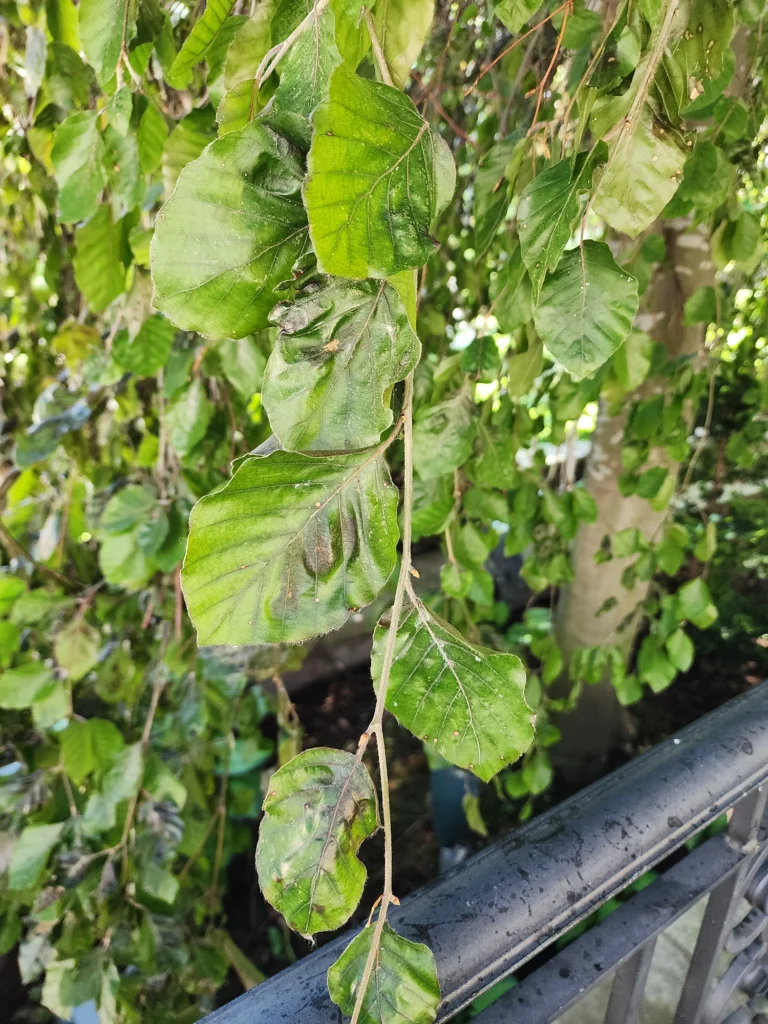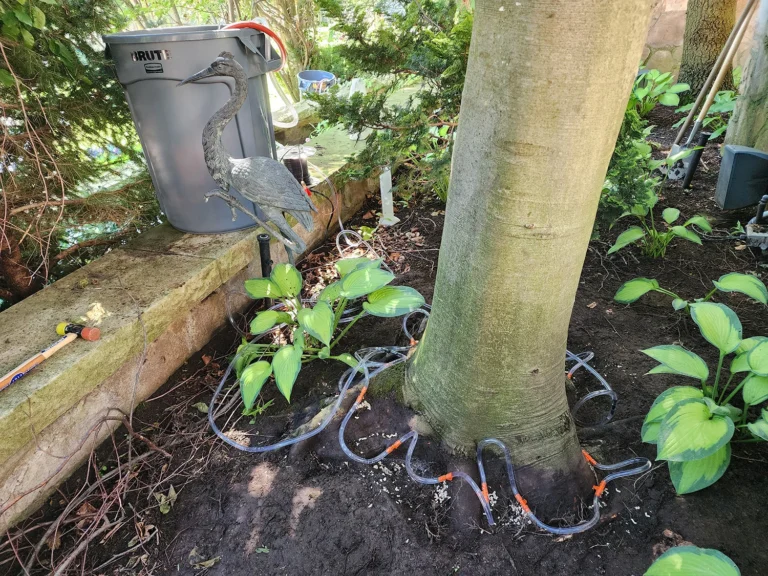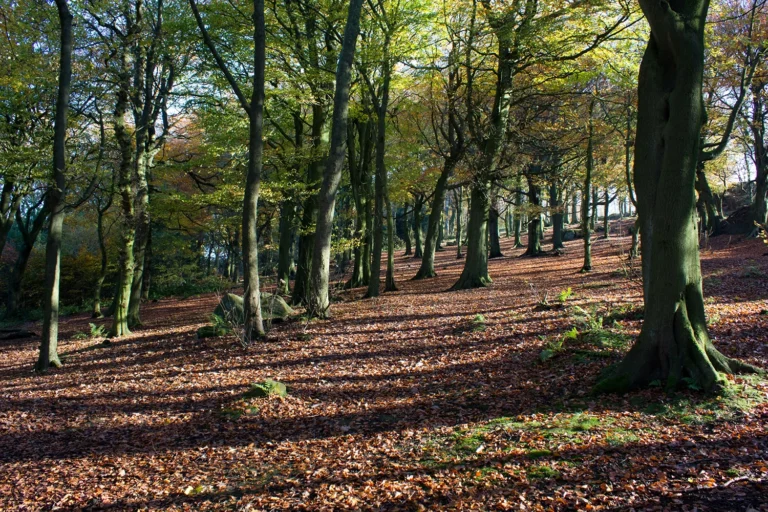Home » Beech Leaf Disease in Ontario: Your Guide to Signs, Risks & Treatment Options
Table of Contents
If your yard or commercial landscape includes beech trees, there’s a growing threat you should be aware of: Beech Leaf Disease (BLD). This destructive plant pathogen is spreading across parts of North America, and it’s now a serious concern in Ontario.
Whether you’re a homeowner with a single shade tree or manage a commercial property with a wooded area, knowing how to identify and respond to BLD can help protect your landscape investment.
What Is Beech Leaf Disease?
Beech Leaf Disease is caused by a microscopic worm-like organism known as a nematode (Litylenchus crenatae mccannii). The disease was first detected in Ohio in 2012 and has since spread to Ontario, affecting native and ornamental beech trees. The pathway of spread is still unclear, but it is suspected that the pathogen could be spreading by wind, through leaf-feeding insects. Because a nematode is associated with BLD and is thought to be a vector, it is also possible that free water on leaves could allow the nematodes to swim from infected to uninfected leaves.
BLD can weaken and eventually kill trees within a few years. Younger trees are the most vulnerable but established and mature trees can contract beech leaf disease as well.
Here is a simple, step-by-step process to determine whether you might have beech leaf disease.
Step 1: Identifying a Beech Tree
If you’re not sure whether you have a beech tree on your property, here are some identifying features:
✔️ Common Characteristics of Beech Trees: see corresponding photos on photos below
- 1. Buds: Long, slender, distinctive, sharply pointed winter buds.
- 2. Leaves: Oval with pointed tips, smooth edges (American beech) or slightly toothed (European beech), with prominent straight, parallel veins; Leaves turn brown in November and persist on tree throughout winter
- 3. Fruits: spiky brown (1.5 cm), encapsulating a shiny brown nut
- 4. Bark: Smooth, light gray bark, often likened to elephant skin.
- 5. Shape: Broad, dense canopy; large mature trees can grow 20–30 m tall.
- Species in Ontario:
- American Beech (Fagus grandifolia): native and widespread.
- European Beech (Fagus sylvatica): often planted ornamentally in urban landscapes
Step 2: Monitoring for Beech Leaf Disease
Once you’ve identified a beech tree on your property, it’s time to inspect for signs of beech leaf disease.
What to Look For:
✔️ Early Symptoms:
- Dark bands between veins on leaves (these are even more visible when held up to the light).
- Leaf curling or puckering, sometimes resembling water damage.
- Leaves may appear thicker or leathery.
✔️ Advanced Symptoms:
A recent article by OMAFRA states that, after multiple years of infection and damage, leaves will emerge completely distorted and stunted and eventually, twig dieback will be evident.
- Sparse canopy, fewer leaves than normal.
- Premature leaf drop, mid to late summer.
- Twig dieback and eventual branch decline.
- Young trees may die within 2–5 years.
✔️ When to Inspect:
- Spring to late summer is ideal, when leaves are fully formed.
Step 3: What Should You Do If You Suspect BLD?
Take clear photos of affected leaves and canopy thinning. Include both close-ups and wider shots of the tree’s canopy. Send them to our office ([email protected]) and we can help determine whether treatment is an option for your tree.
If you have beech trees on your property and you suspect BLD, report it to EDDMapS Ontario to help with the management of this important disease. You can also learn more about the Beech Leaf Disease Monitoring Network by visiting Beech Leaf Disease Monitoring Network – Invasive Species Centre.
Step 4: What Treatment Options Are Available in Ontario?
As of 2025, there is no cure for BLD, but some treatments may slow disease progression, especially in valuable or high-visibility trees.
- TREATMENT: Trunk Injections
- Trunk-injected fungicides (e.g. ARBOTECT 20-S) are now registered in Ontario.
- Arbotect-20S disrupts the cell division of the BLD-causing nematode, reducing the nematode population and the disease
- Arbotect 20-S is typically injected into the root flare of the tree, which is the area where the trunk meets the roots. This allows for efficient systemic movement of the fungicide throughout the tree’s vascular system.
- Injections can be made once leaves are fully emerged (mid-spring to early fall) every 2 years.
- Research has shown that Arbotect 20-S injections can lead to a significant reduction in nematode populations within the tree and an improvement in visual symptoms of BLD.
- Note: trunk injections cannot be made to beech trees less than 13 cm in diameter
- Always consult a certified arborist to assess whether treatment is appropriate.
- Tree Health Support – what you can do
- Water the root zone weekly during hot & dry conditions from May to October.
- Remove competing grasses from the root zone and topdress the soil with 5 to 7.5 cm of natural mulch.
- Avoid soil compaction or soil disturbance within at least 2 meters of the trunk to help maintain tree health and stress tolerance.
- Never pile anything against the trunk, including soil, mulch, stone, weed barrier fabric, stone or edging. Doing so will result in lower trunk rot and constriction.
- Monitor beech trees in the spring and summer to assess health
What Not to Do:
- Do not move infected plant material to new locations, this includes leaves, wood or young trees
- Do not assume leaf damage is always BLD, other pests or diseases can mimic symptoms, including heat and drought stress.
When to Call a Professional
Our ISA Certified Arborists are available to assist you with beech leaf disease and other plant health concerns. At Beautiful Trees Inc., we can:
- Help confirm whether it’s BLD or another issue.
- Provide customized treatment plans.
- Apply trunk injections safely and legally.
Why It Matters
Beech trees are ecologically and aesthetically important. They provide:
- Dense shade for properties
- Habitat and food for wildlife
- Soil stabilization in wooded areas
Protecting your beech trees from BLD helps safeguard Ontario’s biodiversity — and your landscape’s long-term value.
Need help identifying or treating beech trees on your property? Get in touch with our ISA Certified Arborists to create a tree care plan today, before the damage becomes irreversible.
FAQ
Beech Leaf Disease (BLD) is a serious condition caused by the nematode Litylenchus crenatae mccannii. It leads to leaf banding, curling, and eventual tree decline. BLD is spreading across Ontario, threatening both native and ornamental beech trees.
Look for dark bands between leaf veins, curling or leathery leaves, and a thinning canopy. Early detection is key—inspect beech trees from spring to late summer for these symptoms.
While there is no cure yet, trunk-injected fungicides like Arbotect 20-S can slow the disease’s progression in larger trees. Always consult an ISA Certified Arborist for proper diagnosis and treatment options.
Young beech trees can die within 2–5 years of infection, while mature trees may decline more slowly. Prompt action and professional care can help extend the life of affected trees.
Take clear photos of affected leaves and the canopy, then contact a certified arborist for assessment. Reporting suspected cases to Ontario’s EDDMapS also helps track and manage the disease.
Support tree health by watering during dry periods, mulching with natural materials, avoiding soil compaction, and keeping the root flare exposed. Regular inspections by a certified arborist are also recommended.
Do not move infected leaves, wood, or young trees to new locations. Proper sanitation and avoiding the transport of plant material are key steps in preventing the spread of BLD in Ontario.
More Blogs

Beech Leaf Disease in Ontario: Your Guide to Signs, Risks & Treatment Options
Beech Leaf Disease is spreading in Ontario, threatening native and ornamental beech trees. Learn how to identify BLD, what to do if you spot symptoms, and what treatment options are available to protect your property’s trees.
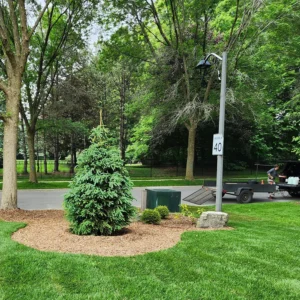
Plant Your Trees Like a Pro: Tips from the Experts at Beautiful Trees
Discover professional tree planting tips from certified arborists Jen Llewellyn and Johl Anderson on the Beautiful Trees podcast. Get step-by-step guidance for planting trees that thrive in Ontario’s landscape.
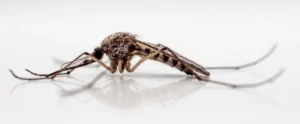
Protect Your Property with Natural Treatments for Ticks and Mosquitoes
Discover how Beautiful Trees Inc. uses plant-based garlic and cedar oil sprays to repel ticks and mosquitoes in Ontario. Enjoy your outdoor space safely and naturally, with eco-friendly treatments that protect your family, pets, and pollinators.
